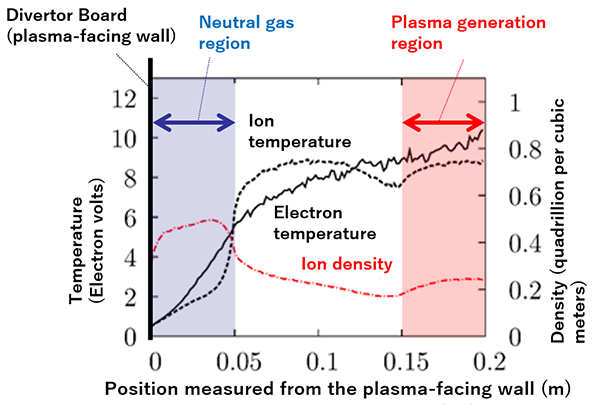HOME > Research Activities > Research Updates >
In the Large Helical Device (LHD) we confine high temperature plasma in the magnetic field. Plasma consists of electrons and ions that have borne electrical charge (charged particles). Due to collisions among these charged particles, plasma diffuses little by little from the core of the LHD toward the wall. Thus, by devising the shape of the magnetic field, the plasma is led toward a special board called the divertor, and there the particles and heat are received. In the future fusion reactor, it is foreseen that the divertor board will bear extremely large heat loads. Thus how to reduce the heat load is becoming an important issue. In order to solve this issue, a method called “detached plasma” is being proposed. This is a method for enabling plasma heat to escape by introducing low-temperature neutral gas between the plasma guided to the divertor and the divertor board. (That is, plasma energy is converted into radiation and then released in four directions, and the heat load to the divertor board is lowered.) Research that clarifies the conditions for the generation of this detached plasma and the physical process for achieving that condition is being conducted not only in the LHD but also in the smaller experimental devices in university laboratories. (Regarding research in the LHD, please see back number 298.) Adding to such experimental research, in the detailed physical clarification of detached plasma and its prediction, research utilizing highly precise computer simulation is essential.
Charged particles such as electrons and ions that compose plasma move about influencing each other through the electrical force. However, in detached plasma, collisions between these charged particles and the low-temperature neutral particles also perform important roles. When charged particles and neutral particles collide, a reaction occurs in which electrons are stripped away from neutral particles and the electrons of neutral particles are transferred to ions, and influences the movement of the plasma. For this reason, in order to perform precise simulations of the generation of detached plasma it is necessary to calculate precisely the process in which charged particles react with neutral particles through collisions while pursuing the movements of numerous charged particles based upon the laws of physics. At NIFS, we are advancing in the development of computer programs that will perform calculations from the particle level.
Utilizing highly precise calculation programs, in conducting simulations at the same size as in the LHD a significant amount of time is required even when using cutting-edge supercomputers. Thus, first, we decided to conduct simulations by utilizing a model reduced to approximately one-tenth the size of small-scale linear experimental devices (an experimental device that confines plasma by using straight magnetic field lines) at universities. Then, in order to effectively utilize the performance of the NIFS supercomputer, the Plasma Simulator, we optimize the calculation program. As results of the simulation, we succeeded in reproducing the characteristics of detached plasma, that is, by introducing neutral gas near the divertor board the plasma temperature and the heat load on the divertor fell, and there were steep plasma temperature and density gradients on the surface of the divertor board. Further, we were able to indicate that at the time of the generation of a detached plasma the ion temperature and the electron temperature fall, and that the cause of the temperature reduction is explained from the particle level (the temperature falls due to collisions between ions and neutral particles, and interaction through electric force among ions and electrons).
In this way, based upon high precision simulations, we have already replicated detached plasmas, and have been able to investigate the physics in detail. For our next research topic, in order to heighten further our precision in calculations we will incorporate the process in which ions and electrons combine and become neutral particles, which is important when the plasma temperature becomes extremely low. Further, detached plasma will vary depending upon the differing conditions of the size of the device, the plasma temperature, and the methods of supplying neutral gas and gas species. Advancing the development of the calculation program further, we pursue predictions of generation of detached plasma by understanding the difference of detached plasma depending upon the conditions and contributions toward control methods of detached plasma.

A simulation result based on a linear device model:
The divertor is placed at the edge of the left-hand side. The red color represents the plasma generation area, and the blue color represents the neutral gas area. The curved lines show the spatial distributions of ion temperature, electron temperature, and ion density. Near to the divertor, the ion temperature and the electron temperature both are low, resulting in decrease in the divertor board’s heat load.
